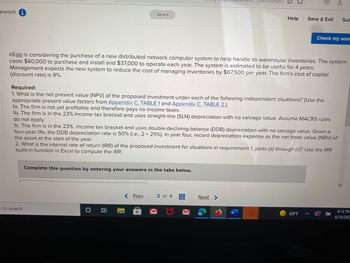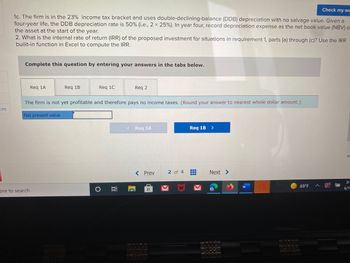
FINANCIAL ACCOUNTING
10th Edition
ISBN: 9781259964947
Author: Libby
Publisher: MCG
expand_more
expand_more
format_list_bulleted
Question
Having trouble with this question. Please advise. Thanks

Transcribed Image Text:ework
Saved
Help
Save & Exit Sub
Check my worl
eEgg is considering the purchase of a new distributed network computer system to help handle its warehouse inventories. The system
costs $60,000 to purchase and install and $37,000 to operate each year. The system is estimated to be useful for 4 years.
Management expects the new system to reduce the cost of managing inventories by $67,500 per year. The firm's cost of capital
(discount rate) is 9%.
Required:
1. What is the net present value (NPV) of the proposed investment under each of the following independent situations? (Use the
appropriate present value factors from Appendix C, TABLE 1 and Appendix C, TABLE 2.)
1a. The firm is not yet profitable and therefore pays no income taxes.
1b. The firm is in the 23% income tax bracket and uses straight-line (SLN) depreciation with no salvage value. Assume MACRS rules
do not apply.
1c. The firm is in the 23% income tax bracket and uses double-declining-balance (DDB) depreciation with no salvage value. Given a
four-year life, the DDB depreciation rate is 50% (i.e., 2 x 25% ). In year four, record depreciation expense as the net book value (NBV) of
the asset at the start of the year.
2. What is the internal rate of return (IRR) of the proposed investment for situations in requirement 1, parts (a) through (c)? Use the IRR
builit-in function in Excel to compute the IRR.
Complete this question by entering your answers in the tabs below.
< Prev
2 of 4
Next >
‒‒‒
8:12 PM
69°F
6/16/202
e to search
O
II

Transcribed Image Text:Check my wc
1c. The firm is in the 23% income tax bracket and uses double-declining-balance (DDB) depreciation with no salvage value. Given a
four-year life, the DDB depreciation rate is 50% (i.e., 2 x 25% ). In year four, record depreciation expense as the net book value (NBV) o
the asset at the start of the year.
2. What is the internal rate of return (IRR) of the proposed investment for situations in requirement 1, parts (a) through (c)? Use the IRR
builit-in function in Excel to compute the IRR.
Complete this question by entering your answers in the tabs below.
Req 1A
Req 1B
Req 1C
Req 2
The firm is not yet profitable and therefore pays no income taxes. (Round your answer to nearest whole dollar amount.)
ces
Net present value
< Req 1A
Req 1B
HH
69°F
ere to search
O Ai
C
< Prev
2 of 4
Next >
S
#
8:
6/1
Expert Solution
This question has been solved!
Explore an expertly crafted, step-by-step solution for a thorough understanding of key concepts.
This is a popular solution
Trending nowThis is a popular solution!
Step by stepSolved in 6 steps with 10 images

Knowledge Booster
Learn more about
Need a deep-dive on the concept behind this application? Look no further. Learn more about this topic, accounting and related others by exploring similar questions and additional content below.Similar questions
- Im having an issue with this problem. Thank you!arrow_forwardA Framework for decision making: a. can help reduce the unexpected consequences of our actions. b. is not needed if the activity is legal. c. helps identify who gains the most from a decision.arrow_forwardWhat is underpricing? Why is it used? What evidence do we have to support the belief that underpricing is a regular problem?arrow_forward
- Describe the term Legitimized disagreement and skepticism?arrow_forwardwhat exactly is a cookie jar reserve? Does using a cookie jar reserve follow GAAP? Does using a cookie jar reserve appear to be an ethical practice? Support your opinion. Your post should be more than a single sentence.arrow_forwardIt says they answers are wrong from your example.arrow_forward
arrow_back_ios
arrow_forward_ios
Recommended textbooks for you

 AccountingAccountingISBN:9781337272094Author:WARREN, Carl S., Reeve, James M., Duchac, Jonathan E.Publisher:Cengage Learning,
AccountingAccountingISBN:9781337272094Author:WARREN, Carl S., Reeve, James M., Duchac, Jonathan E.Publisher:Cengage Learning, Accounting Information SystemsAccountingISBN:9781337619202Author:Hall, James A.Publisher:Cengage Learning,
Accounting Information SystemsAccountingISBN:9781337619202Author:Hall, James A.Publisher:Cengage Learning, Horngren's Cost Accounting: A Managerial Emphasis...AccountingISBN:9780134475585Author:Srikant M. Datar, Madhav V. RajanPublisher:PEARSON
Horngren's Cost Accounting: A Managerial Emphasis...AccountingISBN:9780134475585Author:Srikant M. Datar, Madhav V. RajanPublisher:PEARSON Intermediate AccountingAccountingISBN:9781259722660Author:J. David Spiceland, Mark W. Nelson, Wayne M ThomasPublisher:McGraw-Hill Education
Intermediate AccountingAccountingISBN:9781259722660Author:J. David Spiceland, Mark W. Nelson, Wayne M ThomasPublisher:McGraw-Hill Education Financial and Managerial AccountingAccountingISBN:9781259726705Author:John J Wild, Ken W. Shaw, Barbara Chiappetta Fundamental Accounting PrinciplesPublisher:McGraw-Hill Education
Financial and Managerial AccountingAccountingISBN:9781259726705Author:John J Wild, Ken W. Shaw, Barbara Chiappetta Fundamental Accounting PrinciplesPublisher:McGraw-Hill Education


Accounting
Accounting
ISBN:9781337272094
Author:WARREN, Carl S., Reeve, James M., Duchac, Jonathan E.
Publisher:Cengage Learning,

Accounting Information Systems
Accounting
ISBN:9781337619202
Author:Hall, James A.
Publisher:Cengage Learning,

Horngren's Cost Accounting: A Managerial Emphasis...
Accounting
ISBN:9780134475585
Author:Srikant M. Datar, Madhav V. Rajan
Publisher:PEARSON

Intermediate Accounting
Accounting
ISBN:9781259722660
Author:J. David Spiceland, Mark W. Nelson, Wayne M Thomas
Publisher:McGraw-Hill Education

Financial and Managerial Accounting
Accounting
ISBN:9781259726705
Author:John J Wild, Ken W. Shaw, Barbara Chiappetta Fundamental Accounting Principles
Publisher:McGraw-Hill Education